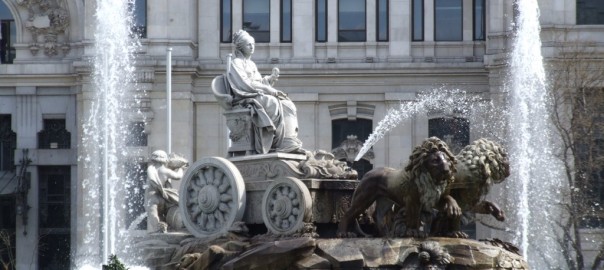April 2007
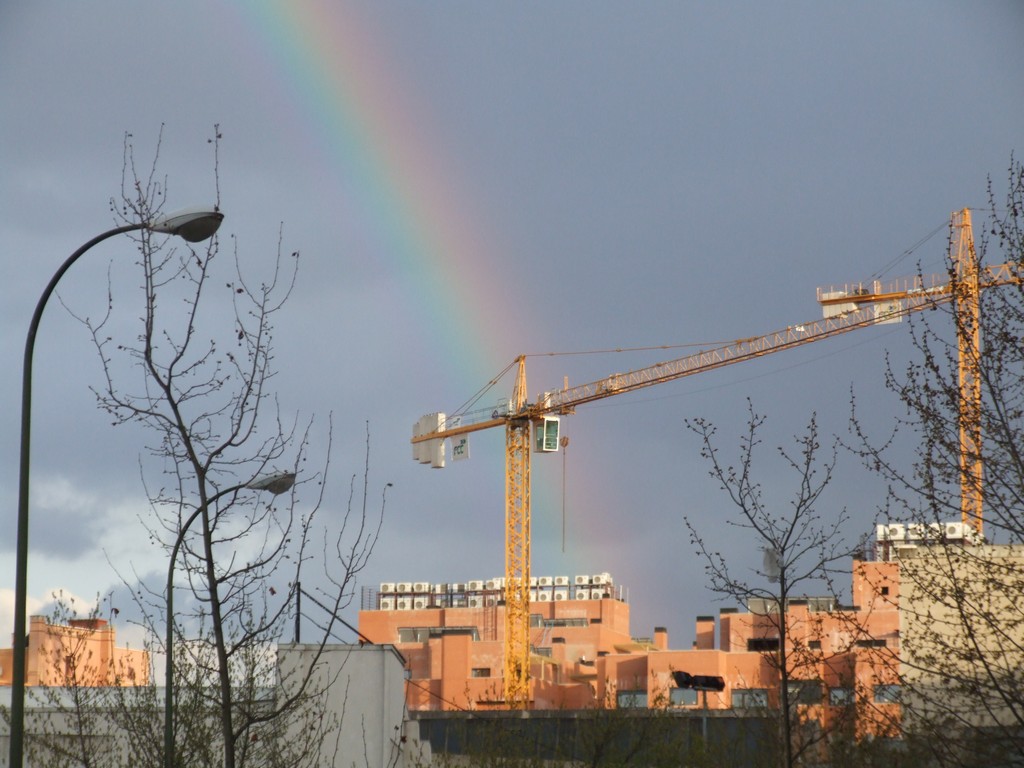
Rainbow over Madrid.
“How do I get to the Metro from here, please?” I asked the painfully thin middle-aged woman on the information desk at Madrid airport.
“Where do you want to go?” she asked.
“Susannez.”
She fixed me with her brown eyes and pushed a lock of greying hair away. From beneath the desk she produced a Metro map and flipped it around to show the network. “I do not know that one,” she said carefully. “Show me.”
I searched for the green line that I had noticed during my researches at home and looked to the right of the map, and a bit north. I found it and pointed to it.
“Suanzes,” she said.
“Swantes,” I repeated and added one more Spanish word to the two I knew already.
“Which hotel?”
It was my turn to be careful. “Comfortel,” I pulled out my accommodation voucher.
“Confortel Alcala Norte,” she said as she read the voucher. “I know where that is.” She dropped a single sheet of a much-photocopied city map on the desk and circled a place near the edge. “Take the 200 bus from the terminal and get off at the first stop. Cross the road and go into the Canillejas Metro station. Two stops and you are there. Here is a map of the city.” She unfolded a big map of the city and its surrounds and put that on the desk, too. I folded it as I thanked her. She gave me a smile and turned to the next person in the queue.
The 200 bus was sitting waiting at the end of the terminal and I pointed to a sign that had the stop where we wanted to get off. The driver nodded and Elaine paid him 2 euros. We paid for a one-week Metro pass each at the Canillejas station, got out at Suanzes and walked about 500m to the hotel, following the photocopied city map. Piece of cake. Nice room, too, with breakfast included and the contents of the mini-bar free!
Elaine had bought a Madrid guide at the airport and we looked at that, and then at the map, to decide where to start. “There are lots of interesting places around the royal palace,” she said. “We could start there, nearest Metro station is Opera – and that’s on our green line.”
We have used underground rail systems in London, Paris, Vienna, Berlin and New York. Madrid’s proved to be no different. The lines were numbered (ours was 5) and coloured (ours was green) and named. On ours you went in the direction of Casa de Campo to go to town, and Alameda de Osuna to go home. It was the same for all the other tracks; find on the map the station you are in, find the station you want to go to, then look for the last station on the track in the direction you want to go. Follow that direction until your destination station arrives. Metro stations are always constructed at interesting places.
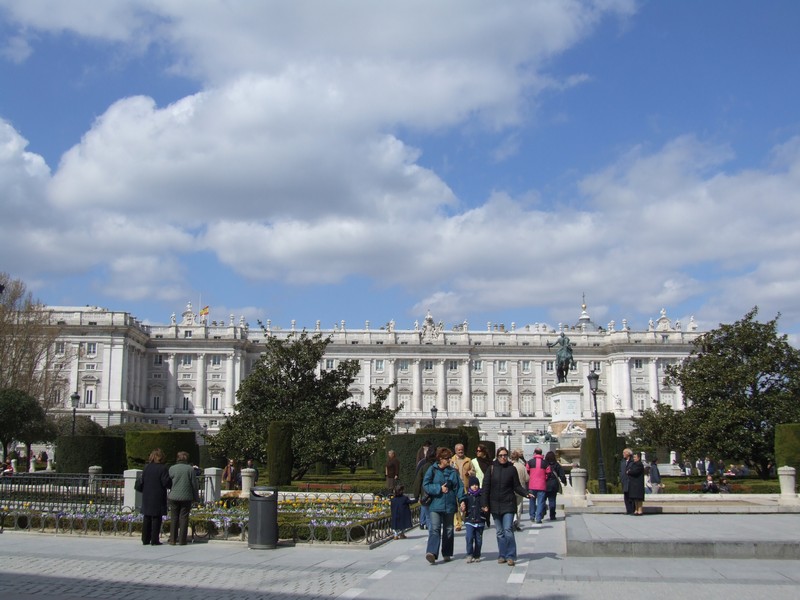
Palacio Real on the Plaza de Oriente.
We arrived at Opera and in the rather weak, watery and uncertain Madrid sunshine that was all we had for the whole week, we found the Palacio Real in the Plaza de Oriente and met our first Madrid accordion player.
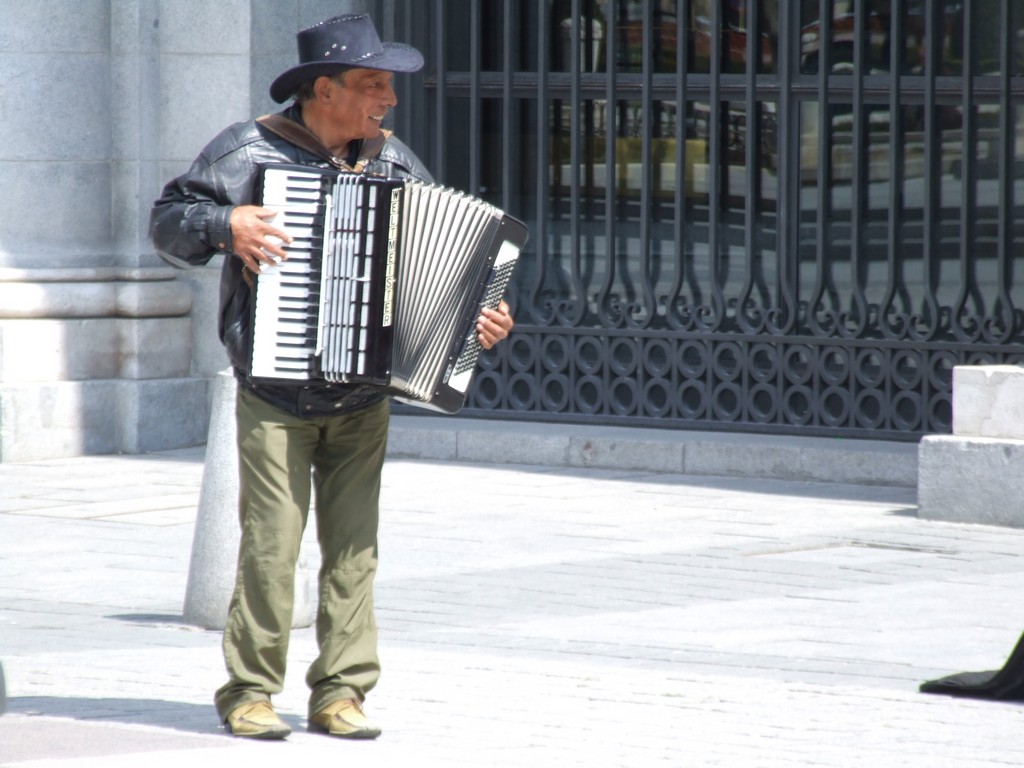
Busker on Plaza de Oriente.
There was a large square with formal gardens, a beautiful white palace, a huge fountain, statues of all the monarchs of Spain since about 450AD standing around the edge of the square looking in and King Carlos IV on his horse on a plinth so high that Galileo had to calculate its centre of gravity to ensure the king didn’t fall off.
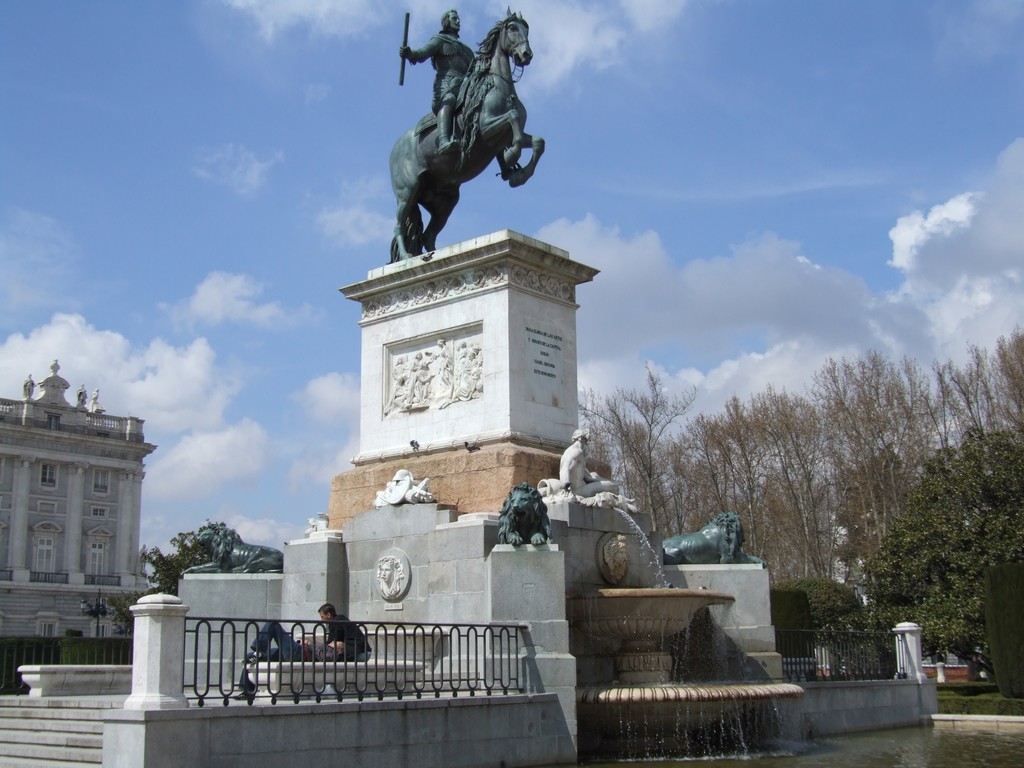
Carlos IV in the Plaza de Oriente.
We walked around to the magnificent Cathedral de la Almudena and admired its complex roof structure.
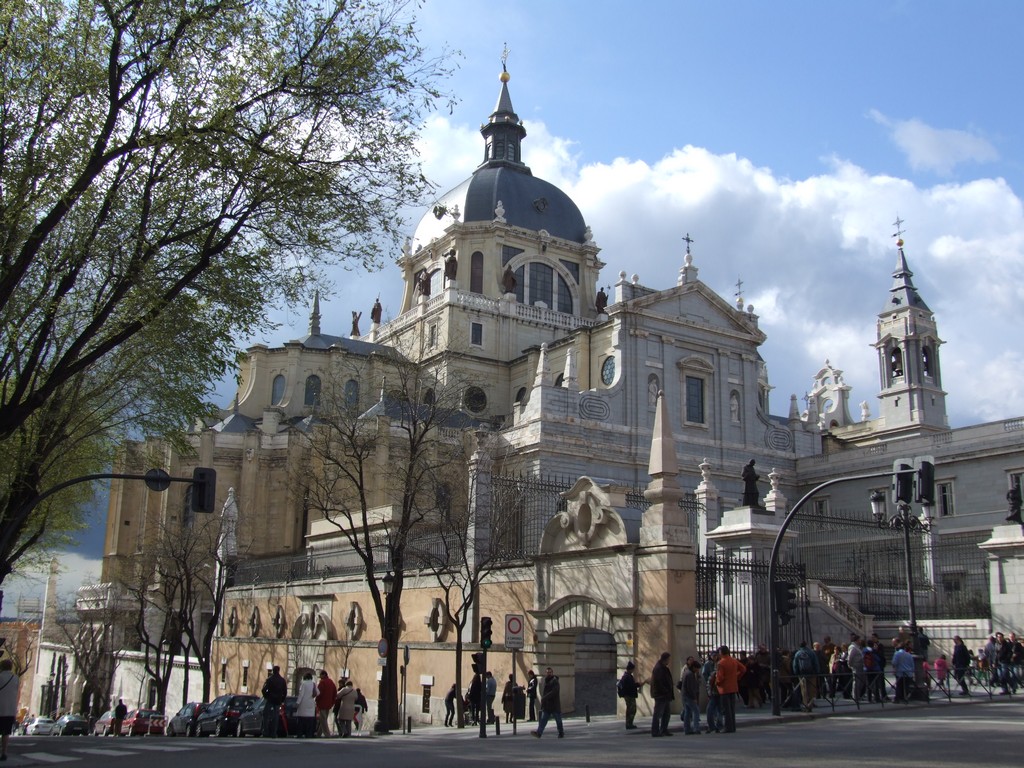
Cathedral de la Almudena.
Inside, its decorations were quite understated, not like the statues of the hundred gory ways the saints had died, along with their relics and their paintings, as we had seen in Seville Cathedral. Tall, vaulted columns leapt upwards and roofing supports swept in enormous waves across the ceilings.
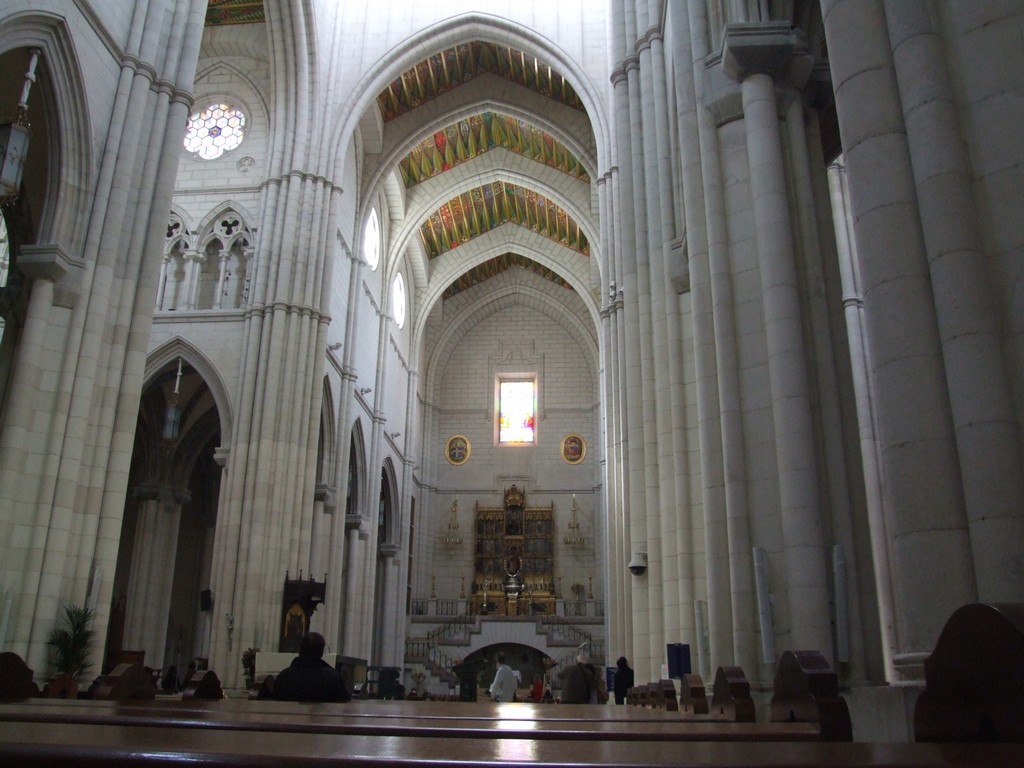
Interior of La Almudena Cathedral.
We wanted to light a candle for Jason, but all they had were rows of LEDs flickering on little white stands under glass with a sign exhorting 1 euro. I know they are worried about fire, but if St Albans Cathedral can use candles, then electronic flames are a bit tacky. We put our euro in the box labelled “For the poor of the parish.”
We looked for the river. Madrid has the Rio Manzanares, famous for its lack of water. Elaine wanted to see the Toledo Bridge and to have a river walk in the sunshine. We walked through the palace grounds, across the beautiful formal gardens, statues and fountains of the Jardines del Campo del Moro, past the Principe Pio railway station and then down a narrow walkway to access the riverbank footpath. There was a weir with a river gate and beyond it was the Puente Reina Victoria, the Victoria Bridge. It’s possible it was named after our own Queen Victoria, since the royals of Europe are all related.
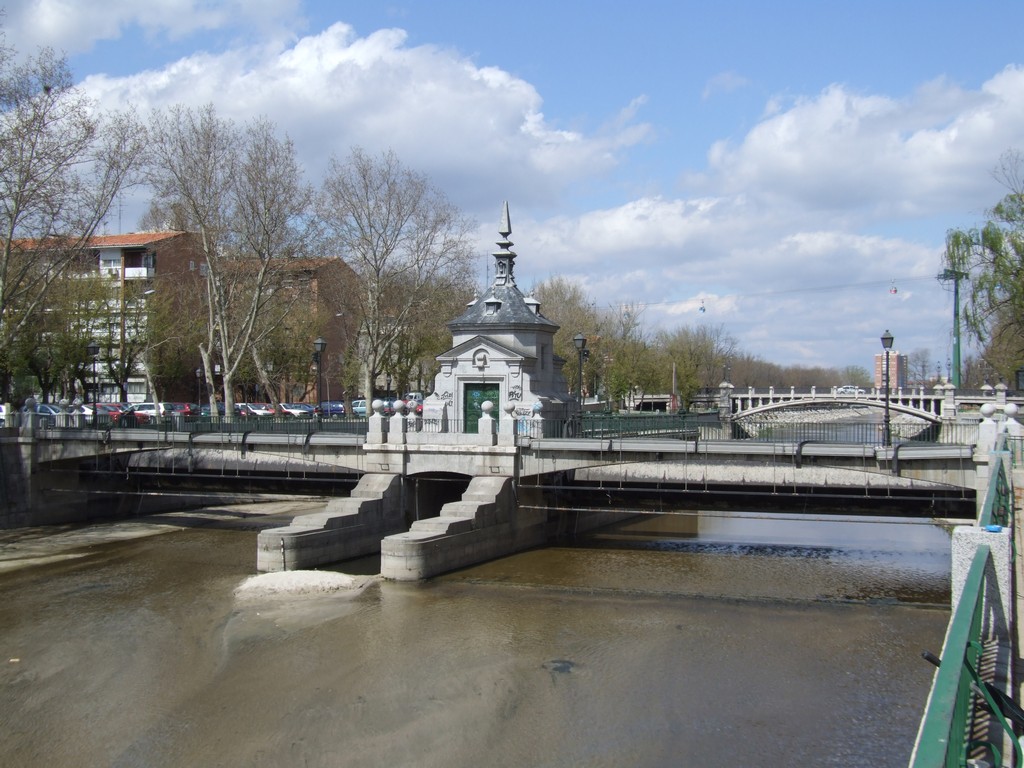
Weir and gate across the Rio Manzanares.
The river would not have been three inches deep over the weir and it did not fully cover the sandy bottom. It was heavily tamed by thick concrete walls, but, amazingly, there were fishermen trying their luck. A hundred metres upstream a couple of anglers were hopefully tossing in bits of bread on tiny hooks to about a dozen red-finned fish that I took to be carp. None of them would have been under three pounds and each of them carefully dodged the offered bait. Either they were not hungry, or they knew too much. How such big fish were sitting in such a small pool was a complete mystery. “Can you eat them, if you catch one?” Elaine asked one of the men. He shook his head.
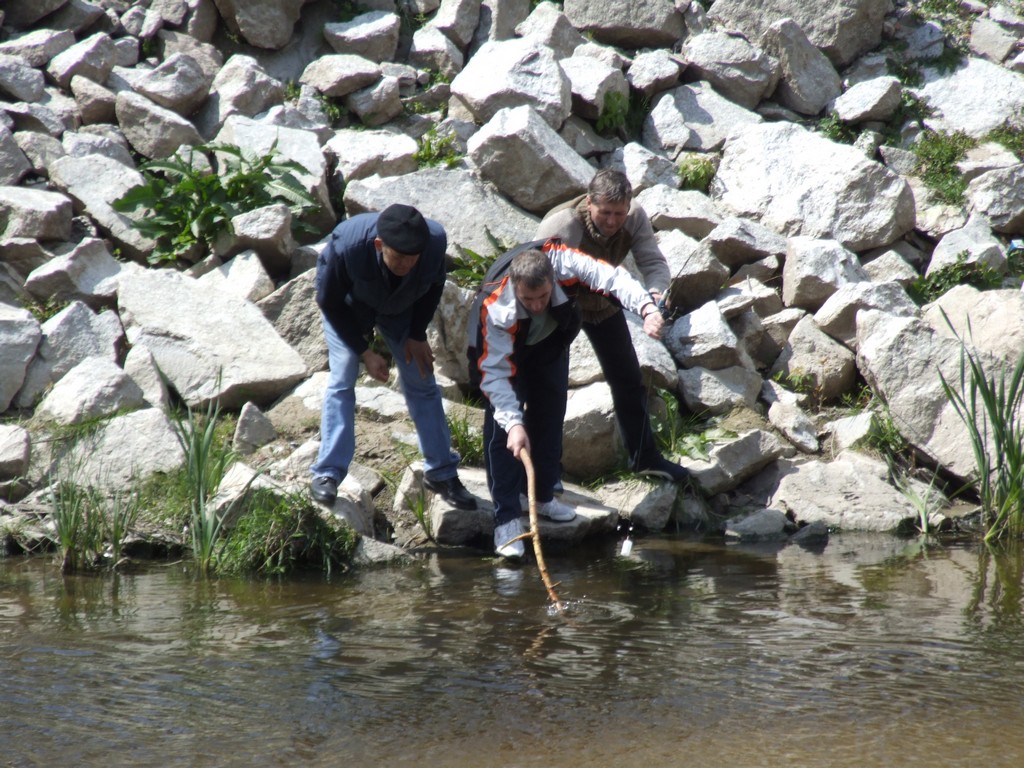
Freeing the hook on the Rio Manzanares, Madrid.
We kept walking upstream until we were past the overhead ropeway, noting that there was none of the river views worship that you get in London along the Thames, in Amsterdam along the canals or in Hamilton, along the Waikato. Like Vienna, Madrid simply ignored the river and 4-storeyed worker accommodation sat with its back to the river along most of its length. We turned back to the Victoria Bridge and walked into the Florida Café for a coffee. On the walls were photos of a Goya statue facing a distinctive little church, and I could see the church immediately opposite us. In fact, there were two of them. After our coffee we were followed outside by a short chap in a brown suit, “Goya,” he said and pointed to a hole in the ground surrounded by bricks.
I looked back to the café and this was the view in the photo. They had removed the statue to make way for all the construction work going on around us. He pointed to the church opposite and left. I thanked him for the tip and crossed the road for a better look. A sign on the cream painted wall of the little half-domed church said Glorietta de San Antonio del Florida. There was a bronze plaque saying this was a national monument and then, on a blue sign I had missed earlier, in Spanish and in English was a story that said the church was built in the 1790s and Goya had painted a scene on the ceiling of a miracle performed by St Anthony of Padua. Hence the San Antonio. It was a celebrated Goya masterpiece and to preserve it, the city had built an exact copy of the existing church in 1929, and closed the old one. The new church was the one used for worship and the old church was opened only on special occasions. Pity.
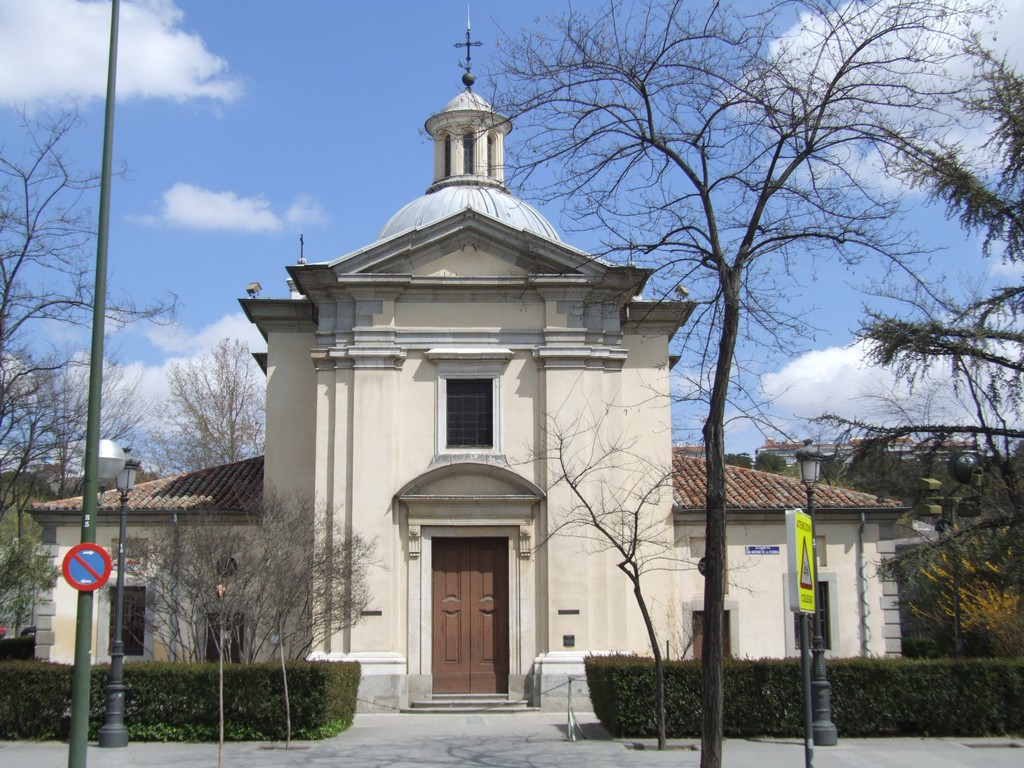
Glorieta de San Antonio de la Florida.
The Toledo Bridge was a mile or so downstream, so we retraced our steps past the Victoria Bridge to the Puente de Segovia. The whole of both sides of the river was a huge construction zone. We called in to see the little brick Ermita Virgen del Puerto church, but it was not open. Elaine’s guide book said it was built in 1780 by the mayor of Madrid to give the washerwomen a place to worship when they went to the river on their daily chores.
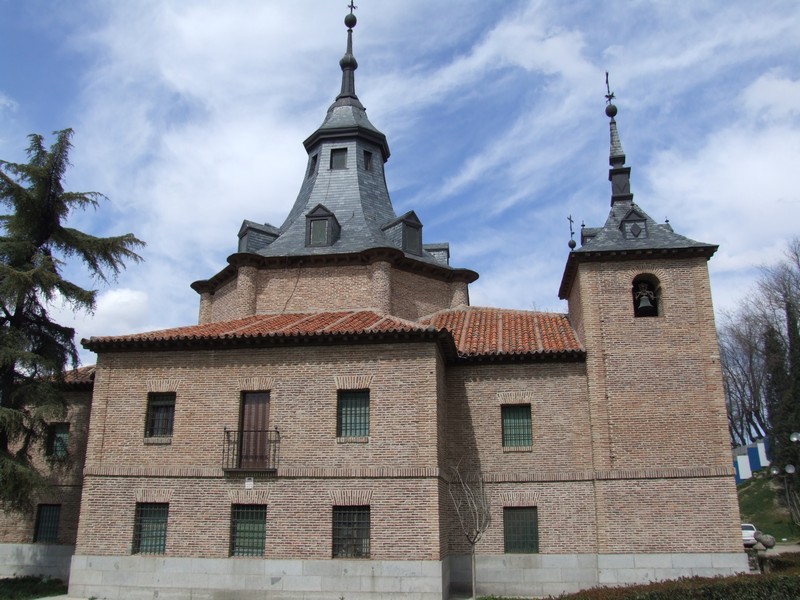
Ermita Virgen Del Puerto
The Segovia Bridge was swathed in protective clothing and the starlings (part of the bridge supports) were fully exposed. Upstream, a culvert had been constructed using very large concrete box-shaped tubes piled on top of each other and surmounted by a new road. If the river does flood badly one year bringing lots of tree debris with it, that will clutter up the square forms and cause a dam. When the buildup finally breaks, as it will, a torrent of water will rush downstream, towards the Segovia and the Toledo Bridges that may well crush them.
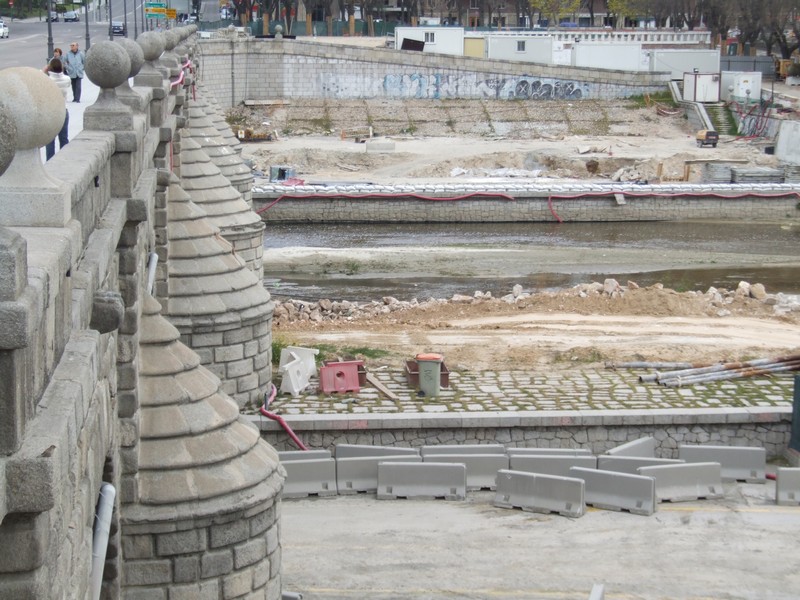
Puente de Segovia
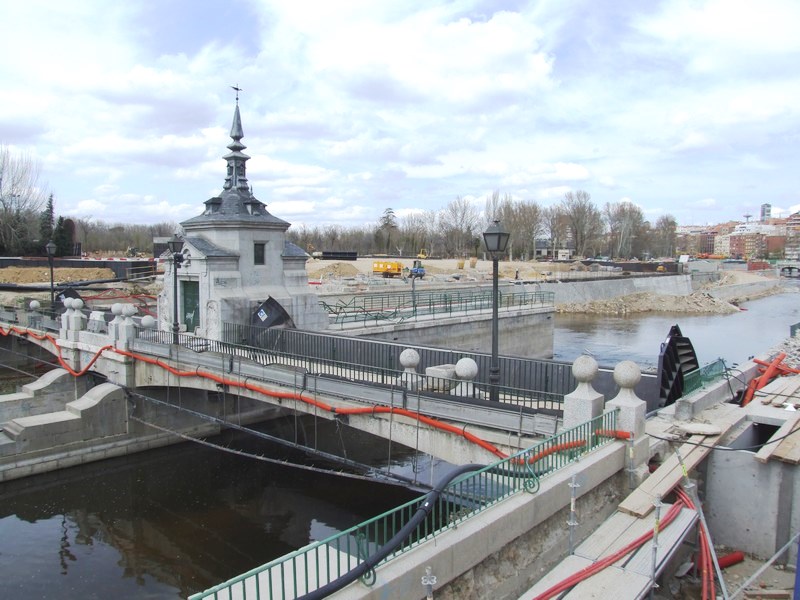
Construction near Puente de Segovia
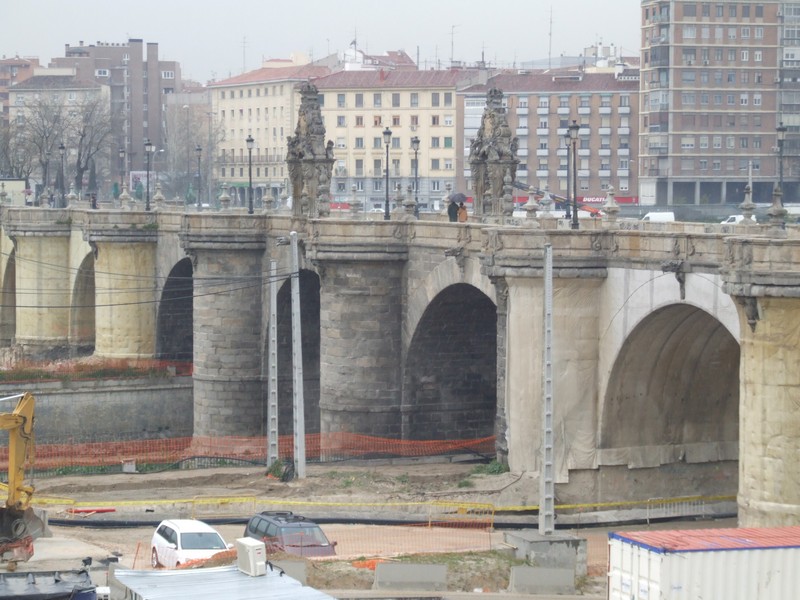
Toledo Bridge
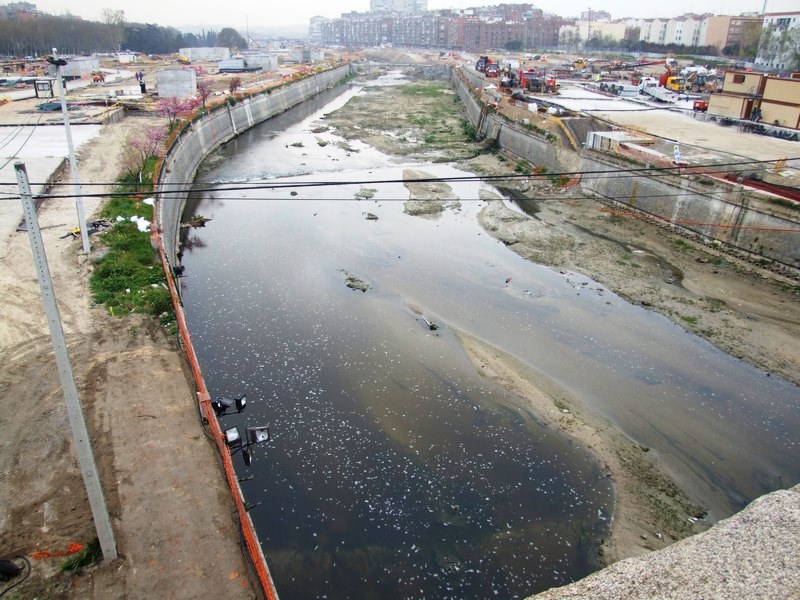
Vast construction site around Toledo Bridge
The Puerto del Toledo shares a bend of the river with the Calderon, a football stadium formally called the Estadio Vincente Calderon.
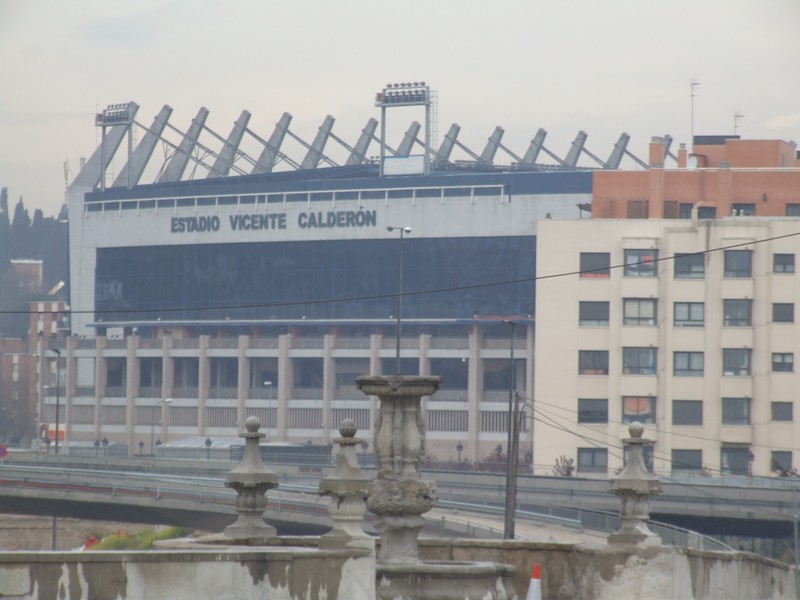
Calderon Stadium from Toledo Bridge
One arch of the bridge is for the river, while the rest of the bridge spans the banks. In the centre of the bridge are two highly carved upstanding things called kiosks, in the middle of which is a hole called a niche. One kiosk has the statue of San Isidro in the niche and the other has Santa Maria de la Cabeza walking with a little girl clutching her skirt.
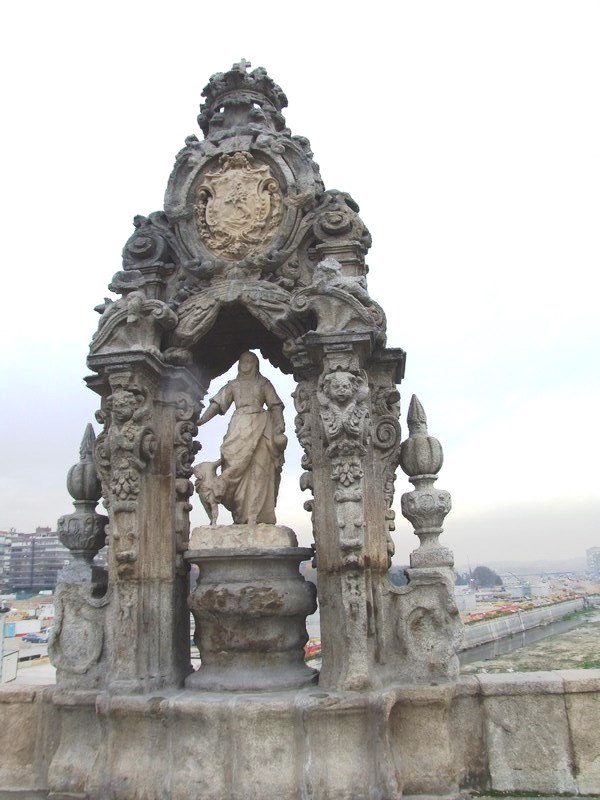
Kiosk on Toledo Bridge containing Santa Maria de la Cabeza in the niche
We crossed the bridge and inspected the Glorieta Marques de Vadillo standing to one side of a busy roundabout. It’s a tall, multi-pointed needle, looking a little like any of the Eleanor Crosses we are used to seeing. I gather glorieta means a memorial.
As we walked up the hill to the Marques de Vadillo Metro station, some chaps in a bar with an open window overlooking the street started to yell at us and wave vigorously.
“Your hat,” said Elaine. “They think you’re Crocodile Dundee.”
I looked up. “G’day, Mate.” They nearly fell out of the window. They had met Dundee.
We put the river behind us to explore the city itself. “The centre of town is probably the Plaza Mayor,” said Elaine one night, examining the map and consulting the guide book over a cup of coffee in the hotel café. “If we go to Opera again we can walk along Arenal to Sol and then left into Calle Mayor to Plaza Mayor.”
We walked down Arenal (which we nicknamed Arsenal to help us remember it) and admired its lovely atmosphere. There are clean new paving stones, it’s fully pedestrianised, the shop fronts are new and clean and the window displays are sophisticated and minimalist.
Sol was a surprise all by itself. It was extremely busy, with large numbers of people, tourists and locals, walking around; beggars worked the crowd. An old woman hunched under a pile of black rags, only her hand with its begging bowl sticking out. As I took her photo she looked up out of the mound directly at me and then curled up again like a snail retracting. I put 50c into her bowl. “There you go, Love.” The black bundle heaved.
Even if you don’t agree with begging, as I don’t, you owe it to them to pay them if you take a photo of their theatrics. A chap with no arms and a red singlet, to make sure you noticed, rattled coins in a plastic cup gripped in his teeth; sometimes up and down and sometimes side to side like a dog shaking a stick, and yelling loudly all the time. Two cops in a Madrid marked Citroen C3 looked on while they talked with two more cops sitting astride BMW scooters. Not motorcycles, scooters, but quite large and very quiet.
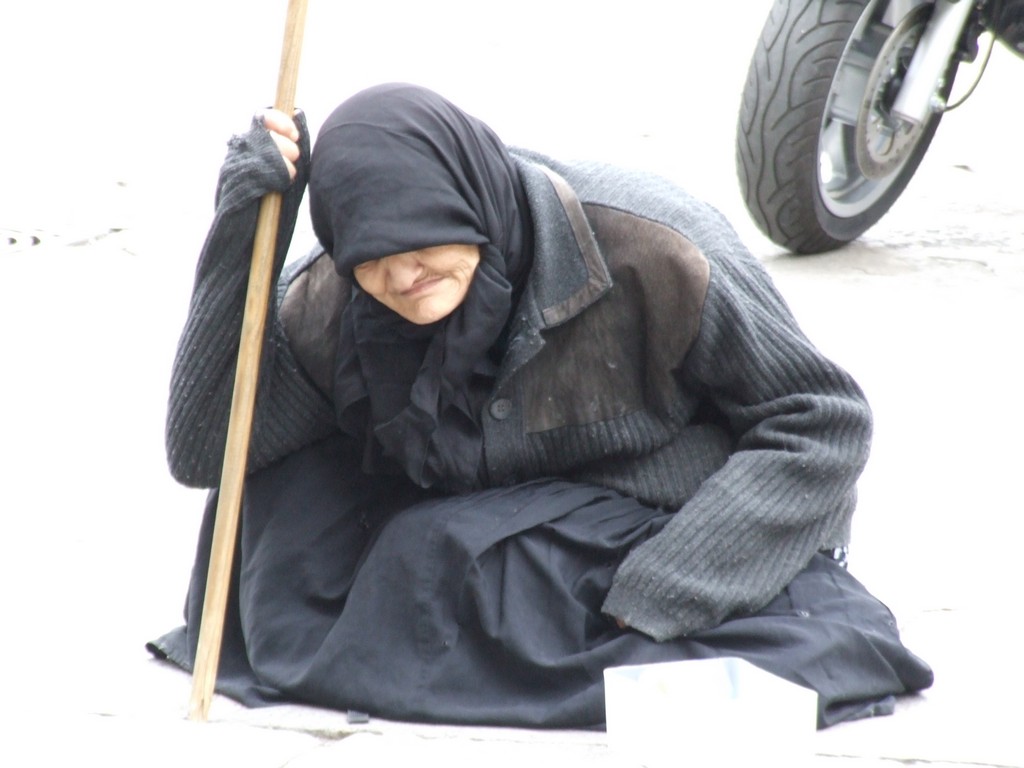
Old begger in Puerta del Sol.
There is supposed to be a big fountain in Sol, but it was the victim of the construction boom and while we were there, its site was enclosed by a steel-panelled circular wall, centred on a tall crane. As a backdrop to it all was a 5-storeyed building topped with a 1920s-style advertisement for Pepe Lopez.
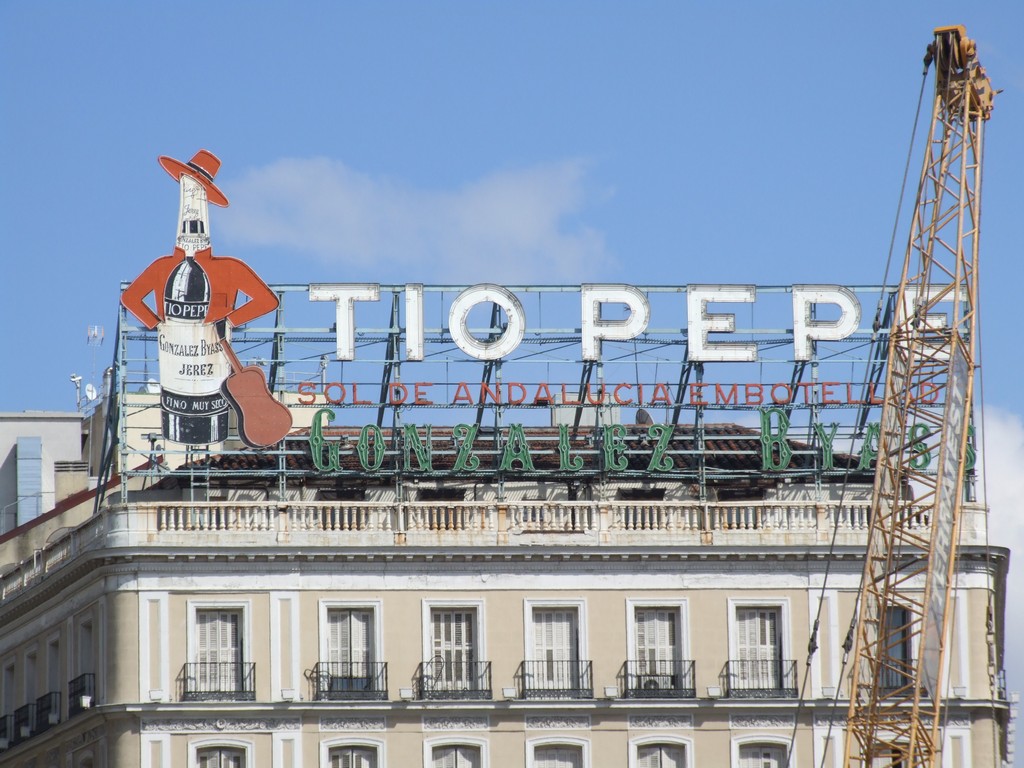
Tio Pepe sign overlooking the Puerto del Sol.
The real highlight for me was the bronze statue of the bear and the madrona. I suppose a madrona is an orange bush, or something very similar. This image of the bear eating the fruit from the madrona tree was everywhere, and used most often by the Madrid council, even down to the ironworks on drain and sewer caps. Sol is also kilometre 0 for all the roads radiating from Madrid; there is a plaque on the ground to mark the spot.
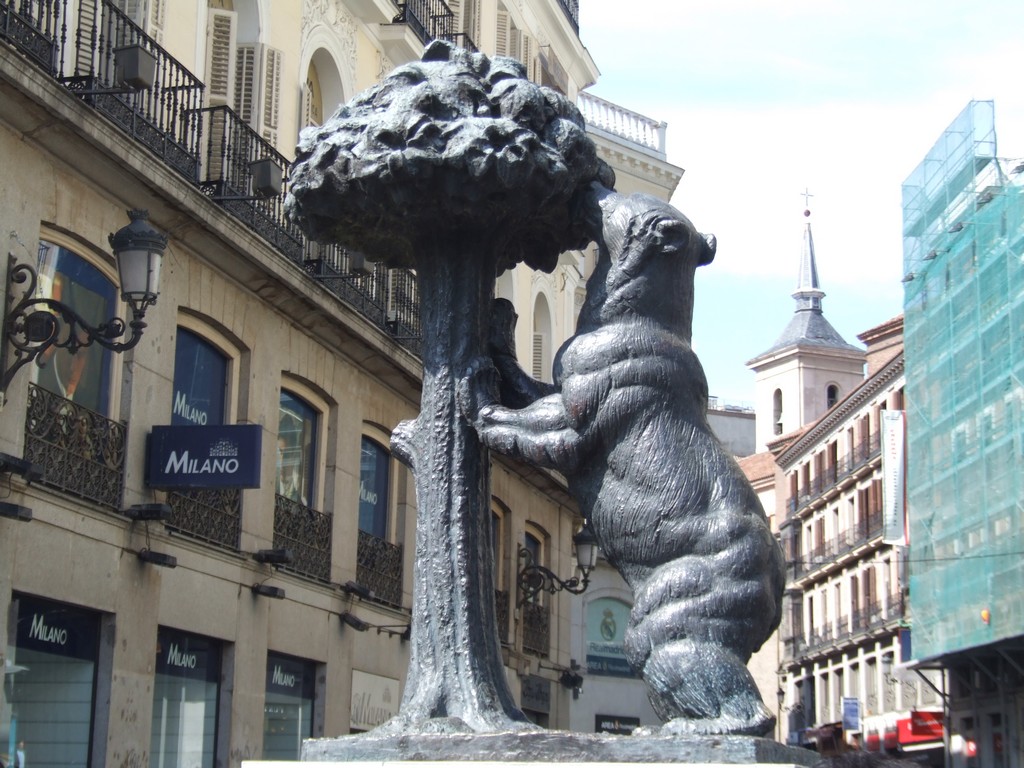
The bear and the madrona in Puerta del Sol.
Plaza Mayor is rather like St Mark’s Square in Venice, and built for the same reason. It’s a great place to show off your royal credentials and the power and prestige of your court. It lacks St Mark’s tower and I don’t think it’s as big, but it is still an impressive place. A rock band was tuning up for an Easter concert and the acoustics were good. A statue of a mounted Philip III stood in the middle of the square and the building in the sunshine was called the Casa de la Panaderia.
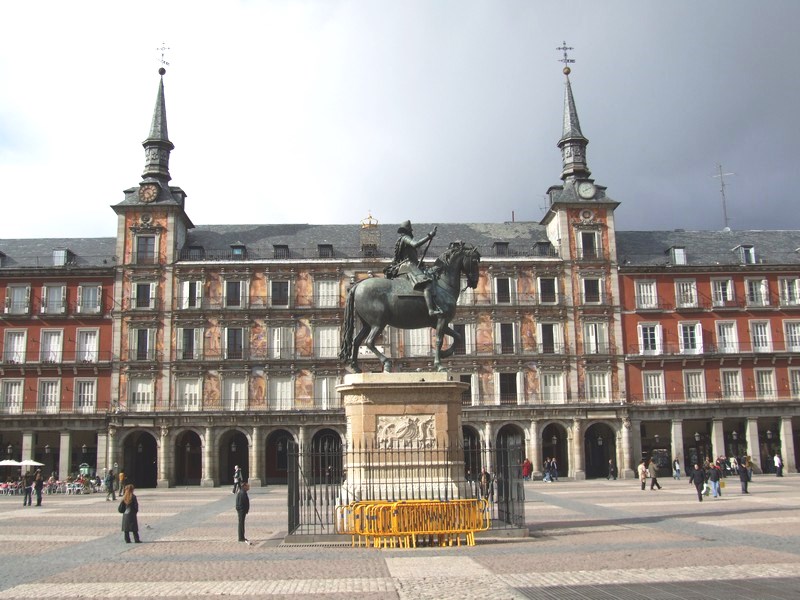
Casa de la Panaderia in Plaza Mayor with Philip III
Two tall towers dominated and paintings of mythical people (mostly naked ones) adorned all the flat areas between the grey-bordered windows and the heavily ornamented architectural elements of the building.
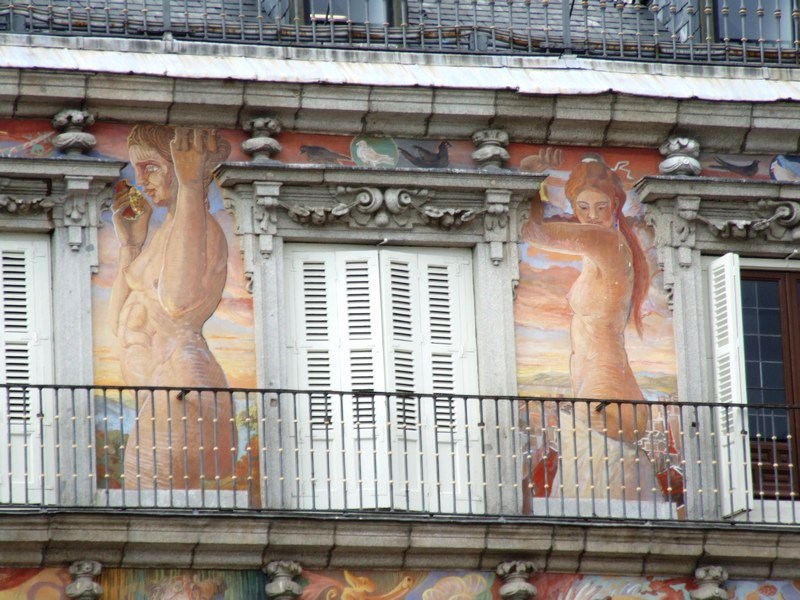
Paintings on Casa de la Panaderia in Plaza Mayor
At ground level around the entire square small shops sold whatever small shops do – coffee, art, antiques and nick-nacks.
“We have to see the square of the Cibeles,” said Elaine that night. “They are the symbol of Madrid.”
“I’ve seen more made of the bear than any Cibeles,” I said.
“They are a woman in a chariot with water gushing all around, so it’s probably easier to draw a bear than the Cibeles. We go to Banco de Espania.” She looked up the metro map. “Swap from our green Line 5 to red Line 2 at Ventas.”
On the Metro, a young chap was smoking from a straw buried in sawdust in a squat bronze vase. He handed it to a girl sitting on his right who tipped water into it from a thermos flask. So they weren’t smoking, and the straw was a copper pipe tipped with brass, like a flute. She took a suck and handed the vase across the chap to a girl who I hadn’t seen, sitting on his left. She took a suck or two and handed it to the first girl who filled the vessel up to the brim. The chap took a drink and as the second girl took the vase I asked her if I could take her photograph, by simply pointing at my camera and then at her. She nodded and I took the shot as she drank. By now the entire carriage was watching. Elaine said, “What is the drink?”
The girl said “Argentine herb tea.”
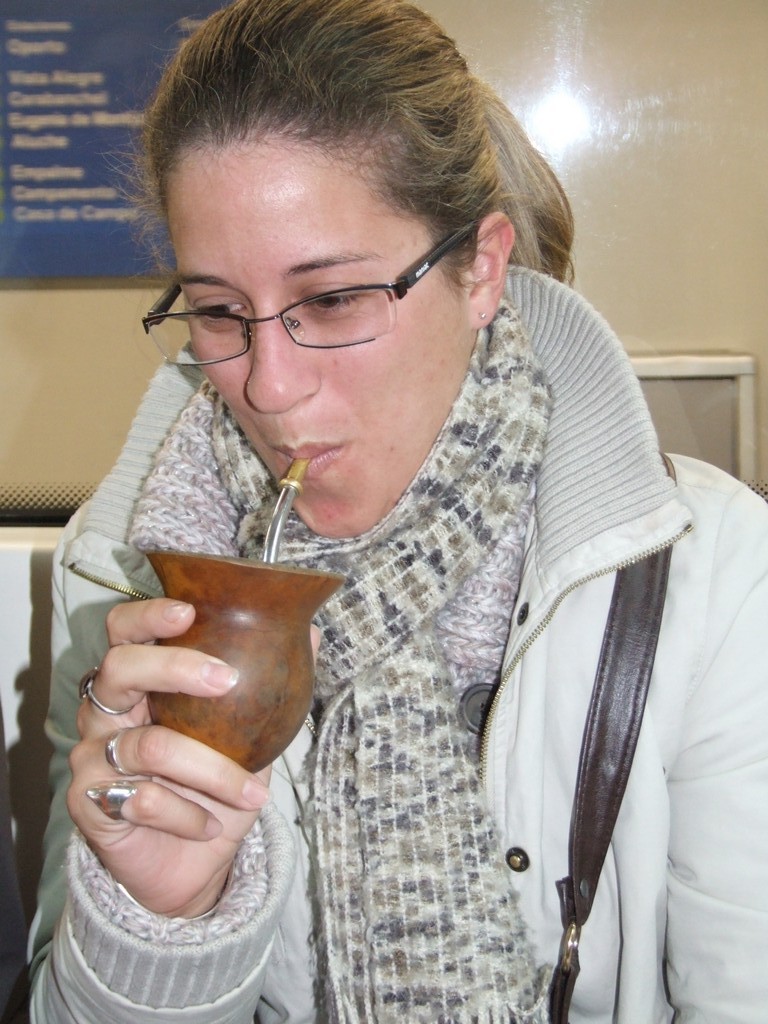
Argentine drinks her herb tea on the Metro.
“You are from Argentina?” She nodded and sucked again, handing the vessel to Elaine. “It’s hot!” Elaine handed it back quickly, declining the offer of a drink. “What is the cup made of? Is it hollowed wood?”
“Melon,” said the girl and made a sawing motion across the top of the vessel.
“Oh, it’s a gourd, and you cut the top off?”
Banco de Espania arrived and we got up to leave the carriage. “Isn’t it wonderful who you meet.”
The first thing you see when you arrive at street level from Banco de Espania is a magnificent view from Calle Alcala all the way up Grand Via to a tall cream tower building called Edificio Telefonica. The Telephone Building.
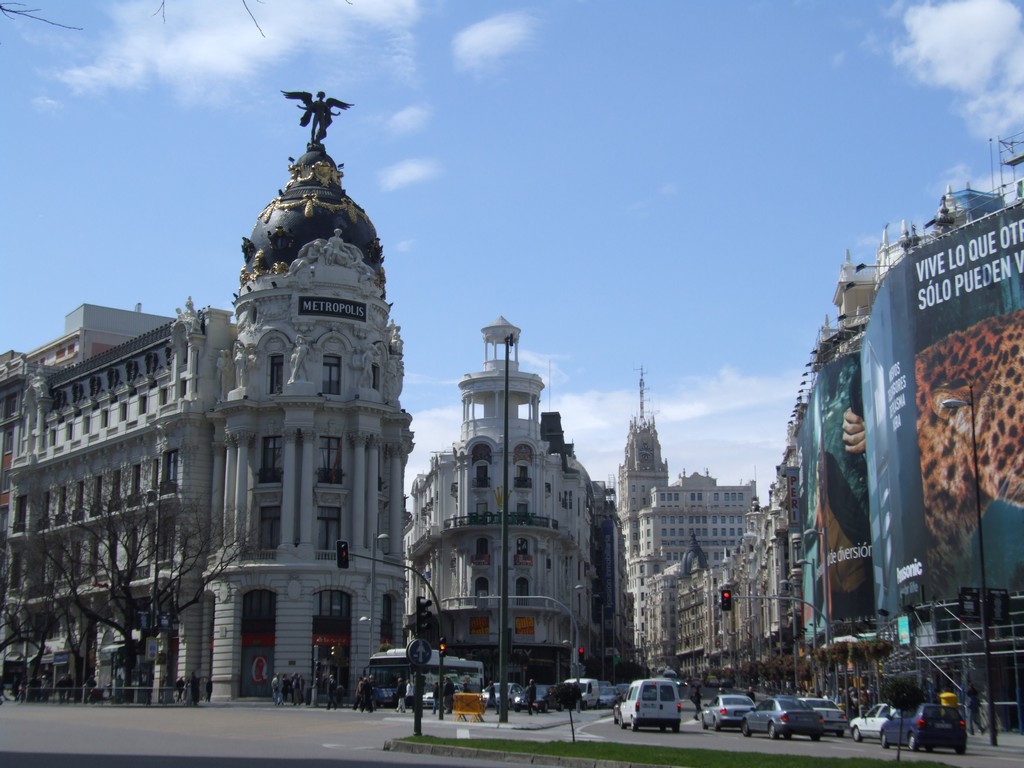
Looking up Grand Via to Telefonica building.
On the corner is the Metropolis with a gold-embossed black dome and a gently curving road along the side of which run grand buildings glowing in the sun. Elaine saw it first, it’s a breathtaking view. We walked down the road towards a fantastically carved building grandly called the Palacio de Comunicaciones – the Palace of Communications. A Telecom Building. Hard to believe.
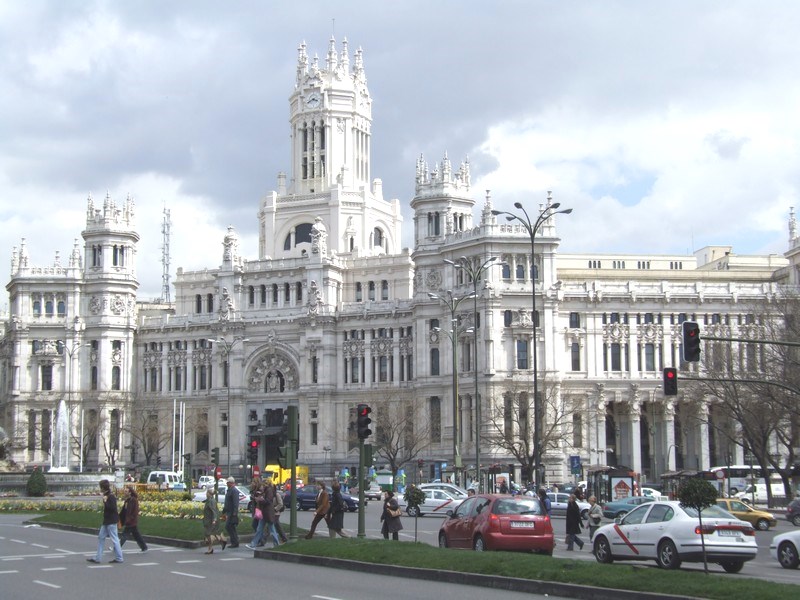
Palacio de Comunicaciones on Plaza de Cibeles
In the centre of what used to be the Plaza de Cibeles and is now just a traffic island was the lovely Fuente des Cibeles. A vertical gush of water to the front announced her coming and another behind guarded her leaving. A spray like a moonbeam or a shooting star, or even a meteor, accompanied the chariot as a beautiful woman rather like our own Brittania made her stately way in a chariot pulled by bronze lions while two little cherubs embraced sensually in her wake.
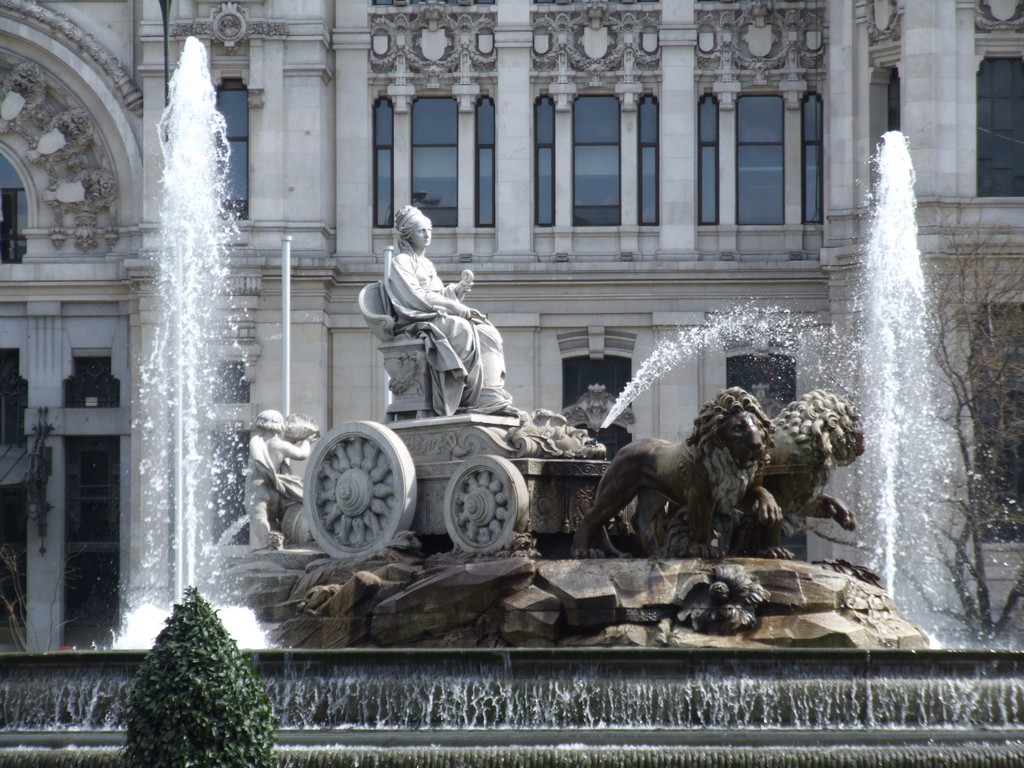
Fuente la Cibeles, Madrid.
“This street is the Calle Alcala,” Elaine explained. “Our hotel is close to this road, and named after it, so that way must be north. This way,” she said turning her back to the Bank of Spain, “up the hill, is the way to the Puerta de Alcala. It’s the gate to the city if you arrive from the south along its most famous road, the Alcala.”
We walked up the hill and she sat down on a streetside bench, in full sight of the gate. “All the round arches are the same height, but the middle one looks bigger because it has an attic. That’s the roof thing on top. The two side arches are square. We have seen photos and souvenirs all around town and now this is your chance to see it up close.” She stopped. “I’m not going any closer because I can see it perfectly well and I know you are going to stand in the middle of the road and ask the traffic to go around you. I’ll come and pick up the pieces if I have to, and I’ll order a cup of coffee in here while I wait.”
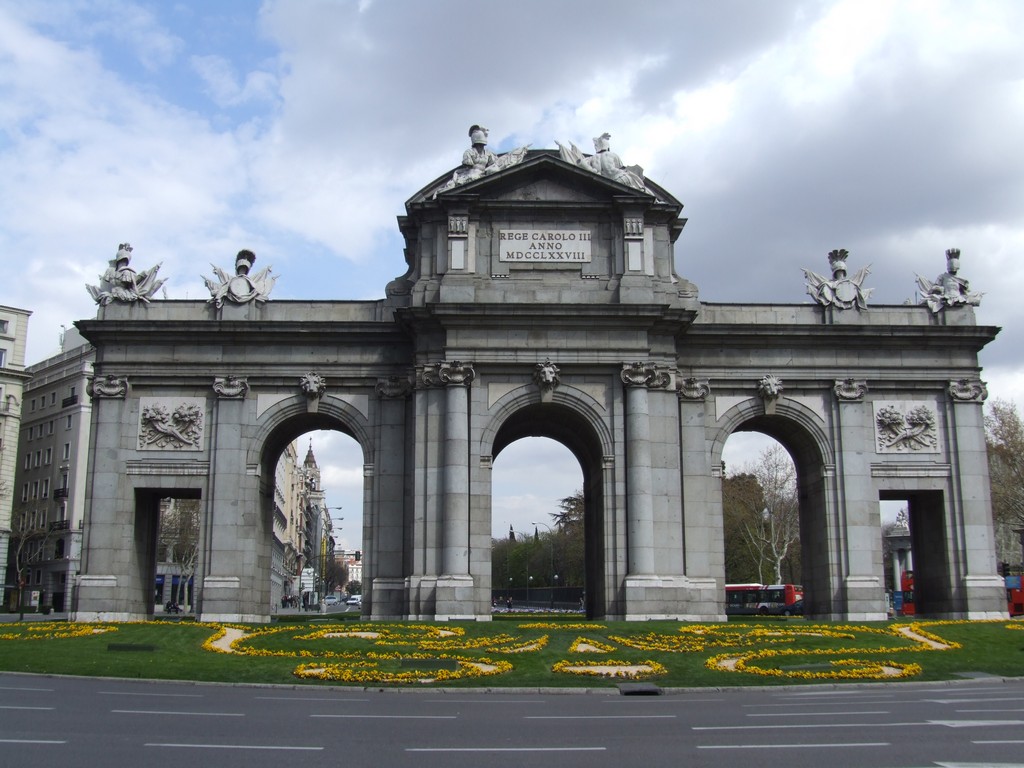
Puerta de Alcala.
She waved at the door of a nearby café and sat down. I made for the gate. She was right, the best shot would be from the middle of the road. I waited for the lights to stop the traffic, walked out into the road and took a few shots while the sun was shining so well. It had been fickle sunshine and quite a sharp, even cold breeze for the whole time we had been in Madrid. The BBC News had been telling us about sunny London and rainy Spain.
I wondered if I could shoot the gate without traffic in front of it. I finished crossing the road and walked up the median strip; slightly to its left where it finished – only a little out onto the road – was the very best place. The gate filled the lens and the lights would stop the traffic. I took my photos of the gate looking as though traffic hadn’t been invented and did the same for a couple who asked me to shoot them with their camera.
That night we trawled the map and the guide book to find the essential Madrid. “I guess there are three things we haven’t seen yet,” said Elaine. “The bullring, the Prado and the leaning towers.” She looked in the guide book, “the Torres Kio.”
“Since the Prado is close to the Cibeles, why don’t we visit the bullring, then the Kio, first?” I suggested.
“In that case, we leave our green line at Ventas in the morning.”
What are we to make of this? A modern European country, a full-time powerful member of the EU with a strong history of diplomacy, how does it endorse such a blood-sport in public, as bullfighting? How has it escaped an edict from Brussels banning the sport? The bull never lives; the odds are heavily stacked against it and we have never heard of a brave bull allowed to live because it defended itself mightily and killed the matador.
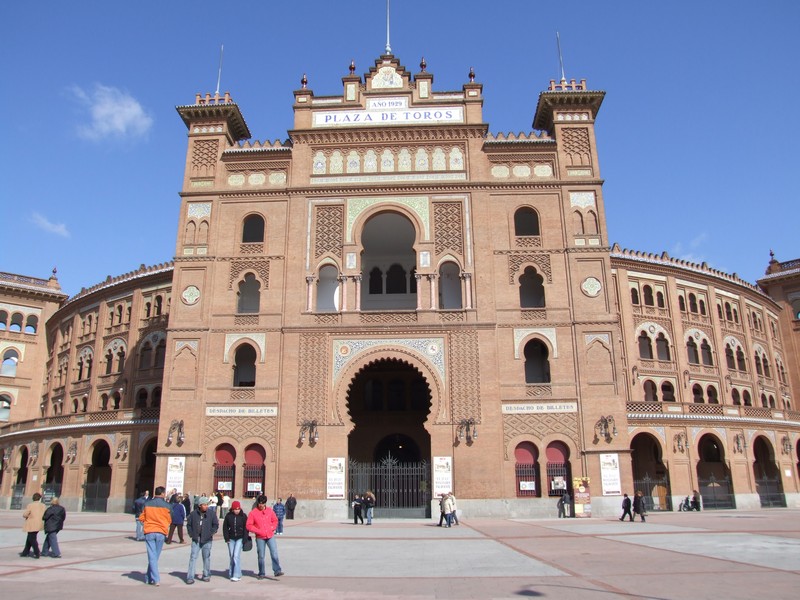
Plaza de Toros Monumental de las Ventas
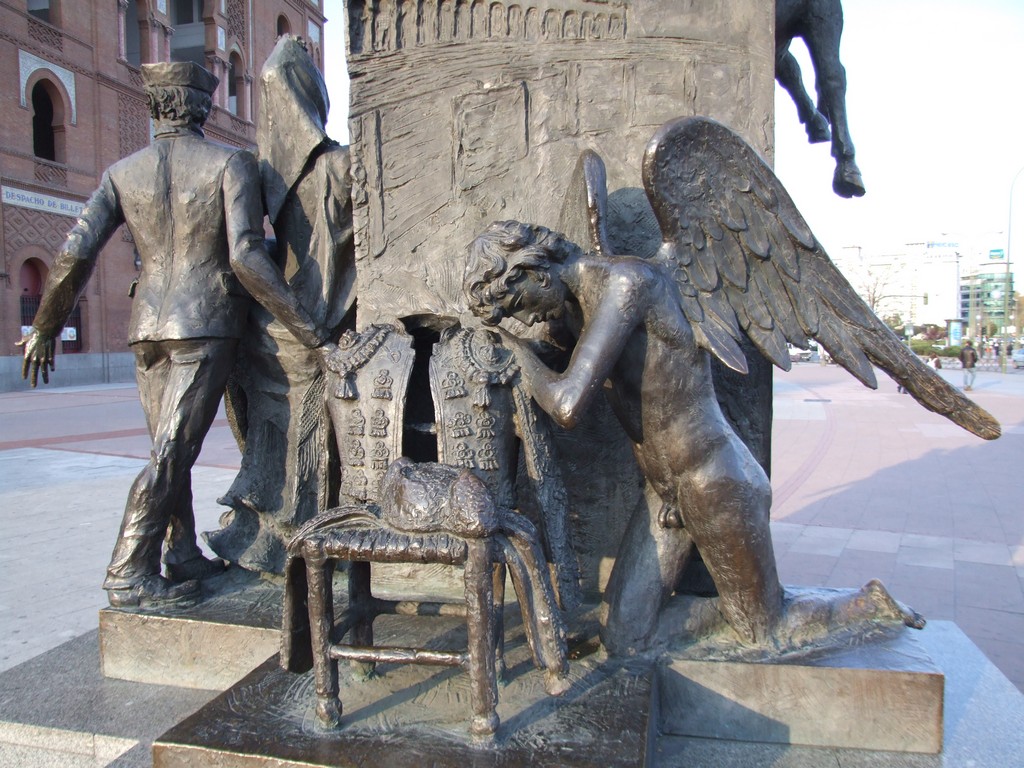
Monument to the fallen.
The bull is not borne high out of the ring in triumph because it fought a wonderful fight. Even if it beats the matador it is still killed and it is dragged out ignominiously through the red dust. We had walked through the bullring at Ronda and even though it was Christmas and therefore some months since there had been an event, we could still smell the blood and rendered fat such as are familiar around a meat works. A bronze relief on the wall at Ventas told the story of the roundup and herding of the bulls. Another statue was a song in bronze to the fallen fighters. Such poetry, such passion, such drama – to kill a bull? A poster announced the next event in the bullring and advertisements on TV kept up the theme.
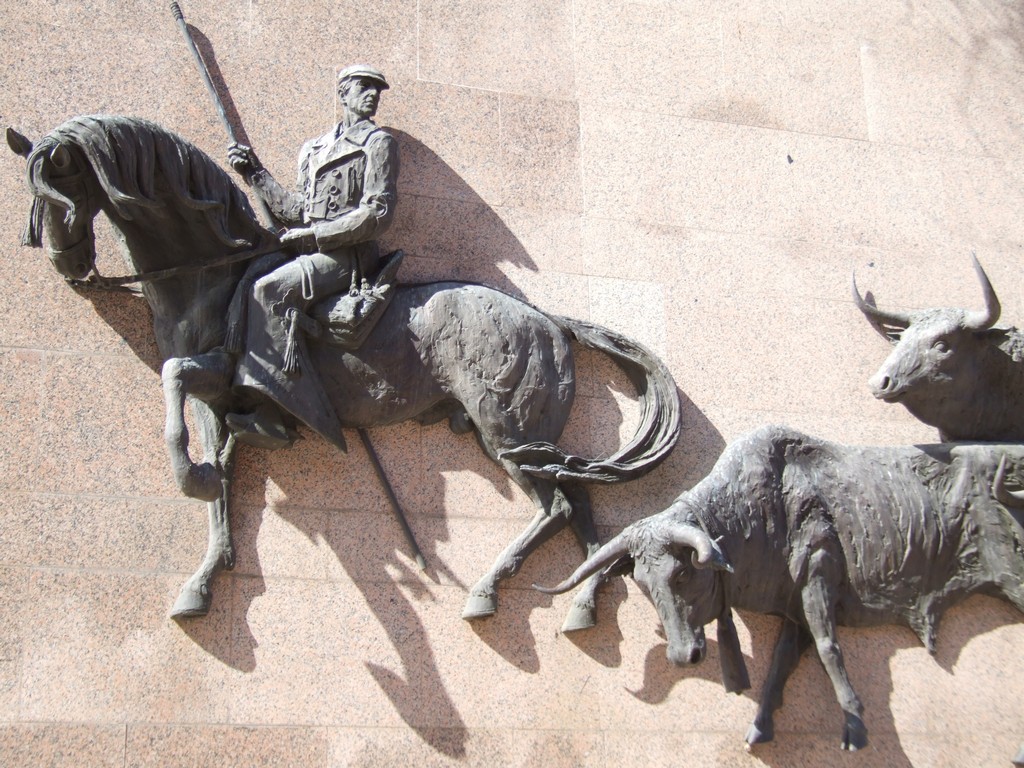
Herding the bulls. Lead cowboy detail, Ventas.
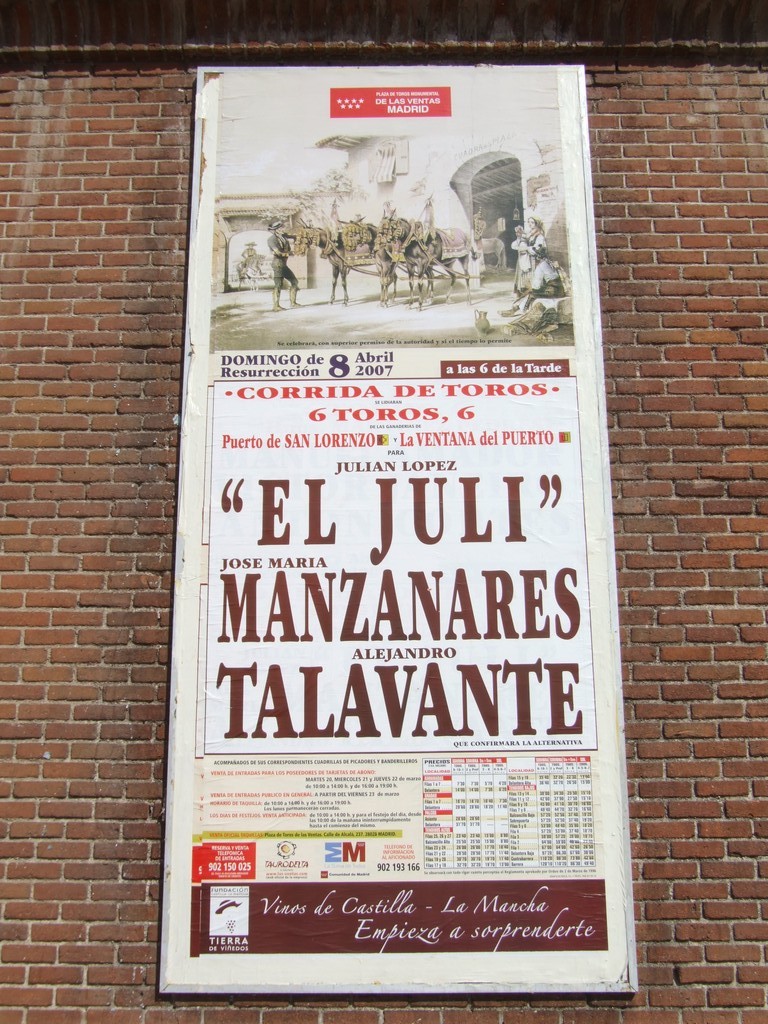
Invitation to the next bullfight, Ventas.
“Santiago Bernabeu,” said Elaine. She, too, was a bit shaken by all of this. “Barry will like that, he collects pictures of football stadia, and there are few more famous than the Bernabeu.” She is a die-hard fan of David Beckham. “We could meet Vicky and Dave, you never know your luck.”
From Ventas we rode the Metro to Alonso Martinez and changed to line 10 for the trip to Santiago Bernabeu.
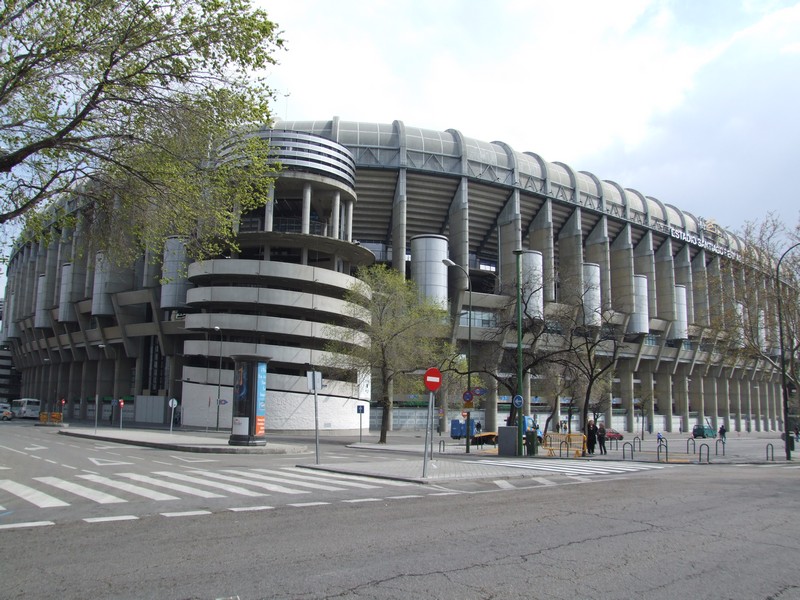
Bernabeu Stadium on Passeo de Castellana
Naturally we took lots of pictures of the Bernabeu, thinking of Barry, and then walked along Passeo de Castellana towards two blue, glass towers that leaned across the road towards each other like schoolgirls sharing a secret. The green symbol of a bear on the left tower is for the Caja Madrid, a bank, while the right hand tower advertises a land agent.
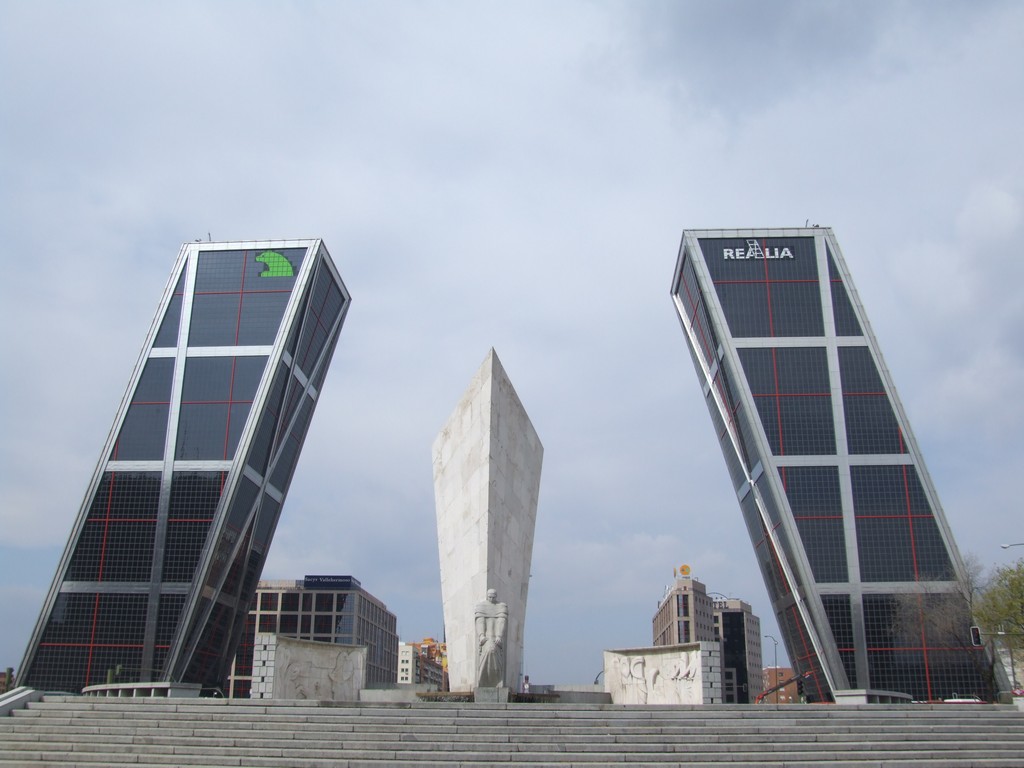
Torres Kio.
On the ground, in the middle of a traffic island in the Plaza de Castilla, is a fountain with someone breaking chains across his knees while two theatrical choruses in stone relief either side encourage him and laud his bravery. It is quite an inspiring work on a grand scale.
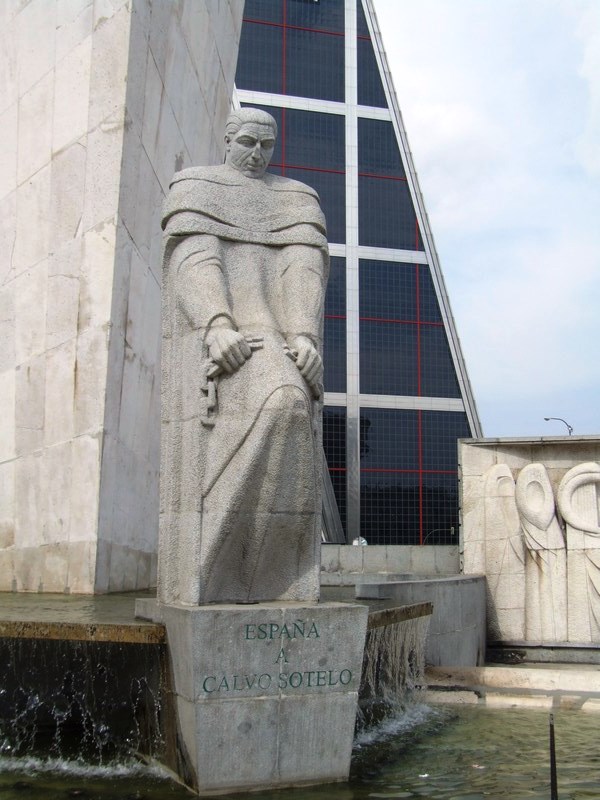
Calco Sotelo breaking the chains between the Torres Kio.
We thought we’d walk back to the Bernabeu Metro the better to enjoy the view and we saw this little tale in bronze on the wall of a café.
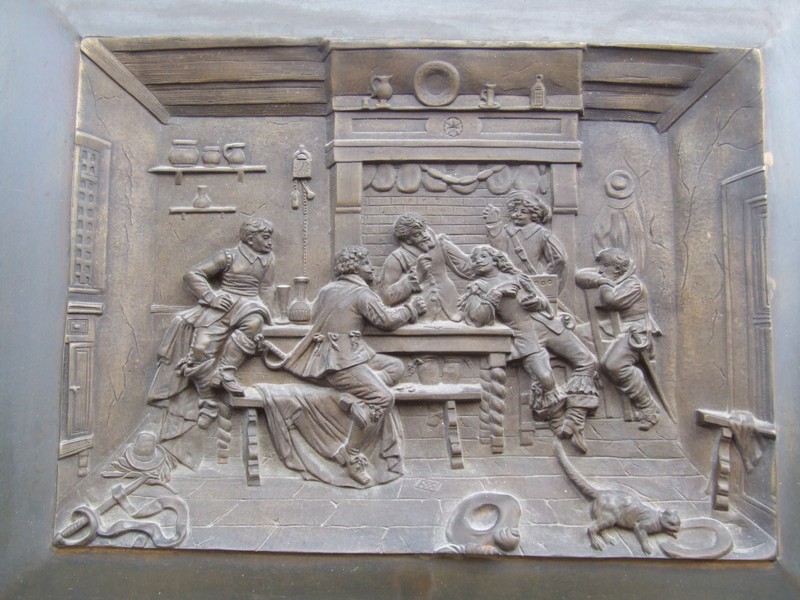
Bronze relief cafe sign near Bernabeu Stadium.
We pushed open the door and a middle-aged man in grey trousers and short-cut hair showed us to a table. We were the only ones there. I ordered Elaine’s favourite, a decaffeinated cappuccino. “Cappuccino descafinado, por favor,” I ordered hopefully. “And a te.” My Spanish was now up to six words.
“Café descafinado,” said the owner, “espresso or milk?” I looked at him blankly; “Cappuccino,” I said. A cappuccino is a cappuccino, why did he ask me for black or white?
“No,” he said and turned away.
A girl wearing a floral pinafore came over and we had much the same conversation, except that she nodded. She followed me over to Elaine and put a little black espresso coffee on the table in front of Elaine and a cappuccino in the middle, between us. I cocked my finger over Elaine’s coffee as though pouring something and said, “Milk, please?”
I remembered agua caliente from our trip to Ronda, it means hot water. I actually had eight words of Spanish, but none of them was leche. I looked at Elaine.
“Leche?” She nodded.
“Yes, please.”
The waitress returned with a tiny white jug full of steaming frothed milk which she poured into Elaine’s cup and left.
I looked at Elaine. “How come I didn’t get a tea? This is a café in a modern European country not a crack-house in some third world hell-hole in South America.” I looked around at the counter, “Why did he say no?” I stopped.
Elaine grinned and pushed my cappuccino towards me. “Live with it.”
The following day was Good Friday and it was raining and miserable, so it was a perfect day to be indoors and looking at paintings and arty things. We headed for the Metro station of Banco de Espania and the Museo del Prado just down the road, one of the most famous and prestigious art galleries in the world. Goya, Valesquez, Picasso. Why not?
Because it’s closed on Good Fridays. We wandered around the Jardin Botanico (the Royal Botanical Gardens) and then the rather grander Parque del Buen Retiro gardens. They are not far from each other and both are tucked in behind the Prado. We took pleasure in photographing the beautiful flowers in the garden. Why pay to see a Goya?
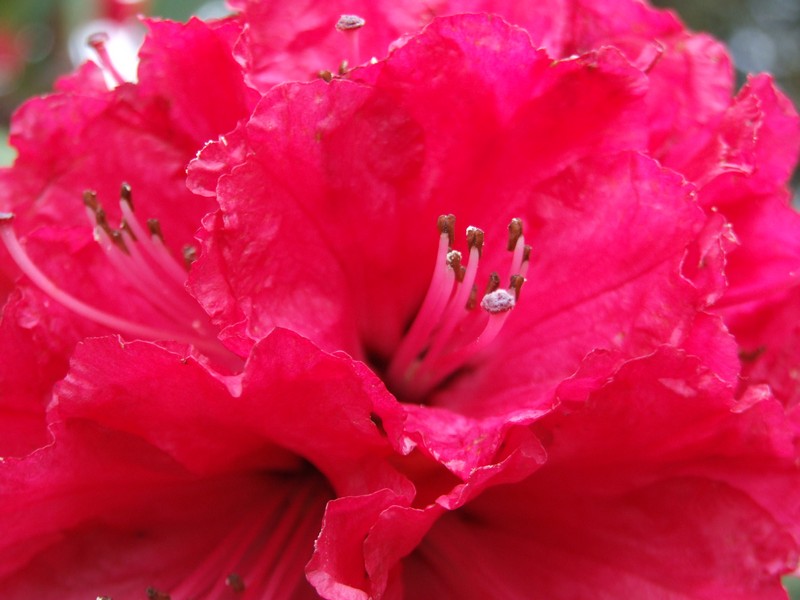
Rhododendran Royal Botanical Gardens
On the way back to the hotel, we came across a most remarkable sight. I cannot for a minute hope to explain it or any of its symbolism, but a procession was forming, centred on the Iglesia San Gines. Older women dressed in black, with lace scarves held off their hair by tall tortoise-shell combs, were making their way slowly towards a side street while they put the finishing touches to each other. Young girls in white cassocks and holding brass-topped canes flipped amongst street dancers and other processioners dressed in white, red or black with their face masks back off their faces until the procession started.
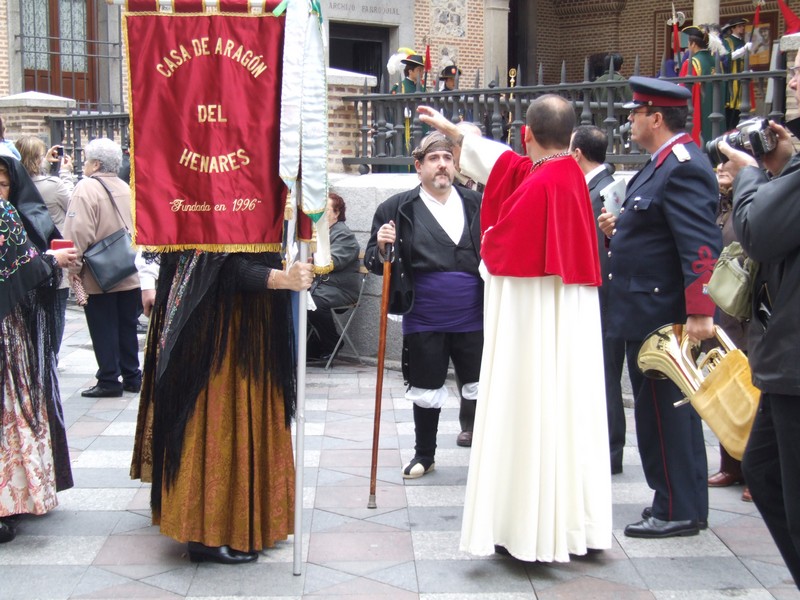
Organising the Easter procession near the Church of San Gines.
Two very small children, perhaps brother and sister, peeped out between the legs of their elders and a gorgeous little girl of about two years old, dressed in deep blue, sat on her father’s shoulder, the better to see what was going on. Two bands of drummers stood waiting, holding up their heavy drums with aching backs. Eventually the whole procession moved off and we, not wishing to disturb their devotions, did not follow them.
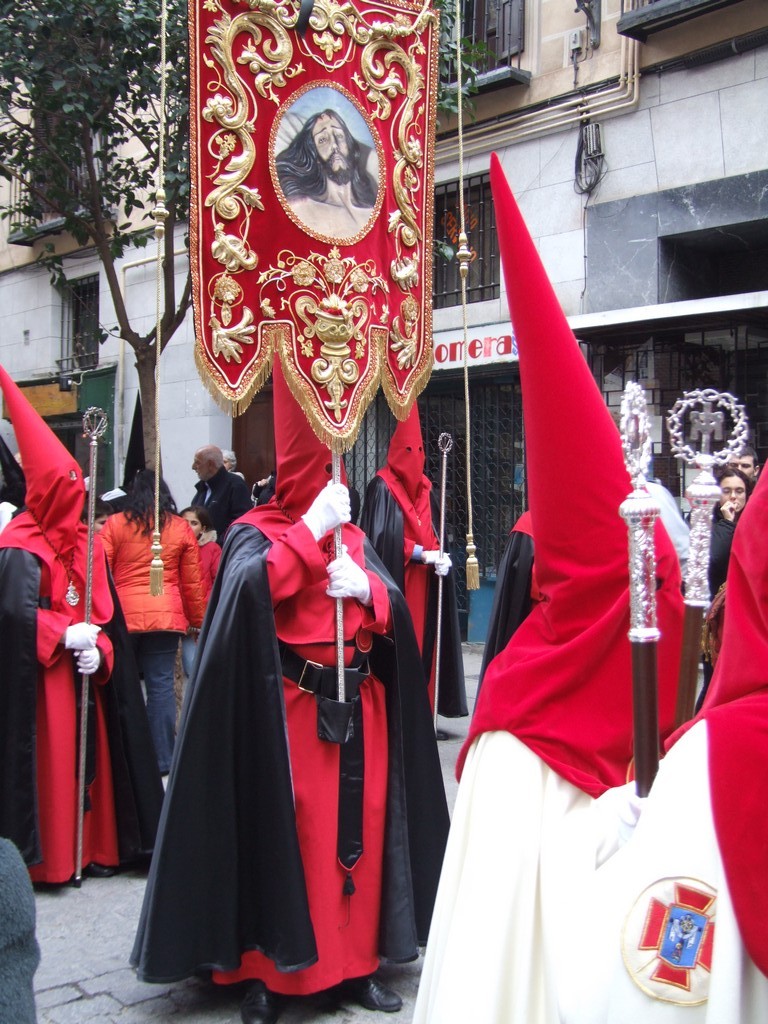
Members of Easter procession.
That night in the hotel cafe I again asked for Elaine’s decaf cappuccino. The waiter gave me a cappuccino and asked if I wanted the coffee black or white. I took them back to Elaine. “I know the secret of the decaf cappuccino.” Elaine raised her eyebrows. “There are two bean grinders; one with proper coffee beans in it and one with decaf beans. You do not use the decaf beans to make cappuccino. It’s not done here. That’s why you get two cups of coffee and no tea. Here’s your cappuccino,” I put it down in front of me, “and here is your descaffinado.” I put it down in front of her.
The following day, Saturday, and our last in Madrid, we went to Banco de Espania Metro again and walked to the Prado. The queue to the front door started at the Cibeles, and the queue to the back door had no end at all. Was it actually possible to visit the Prado? We certainly didn’t manage it.
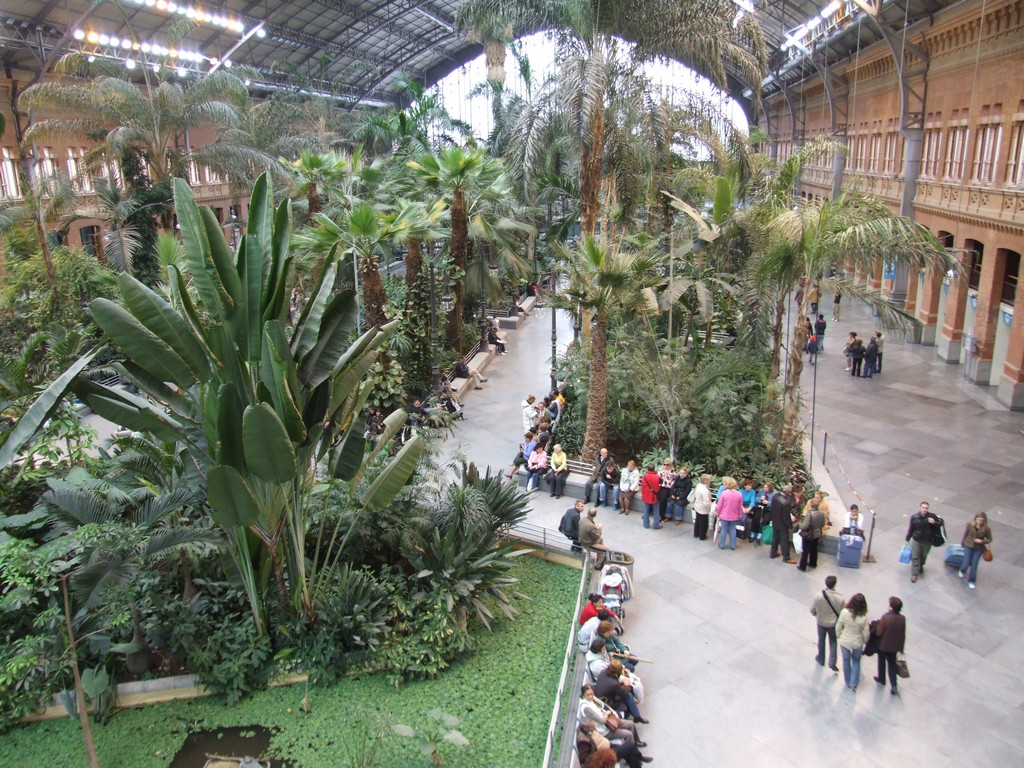
Estacion de Atocha interior.
We visited the Atocha railway station. It’s not exactly compensation for a Goya, but you don’t very often see hundred-foot palm trees growing in a garden inside a railway station that looked like Kew. Opposite, is the Ministry of Agriculture in an ornamented building that is a symphony to European subsidies.
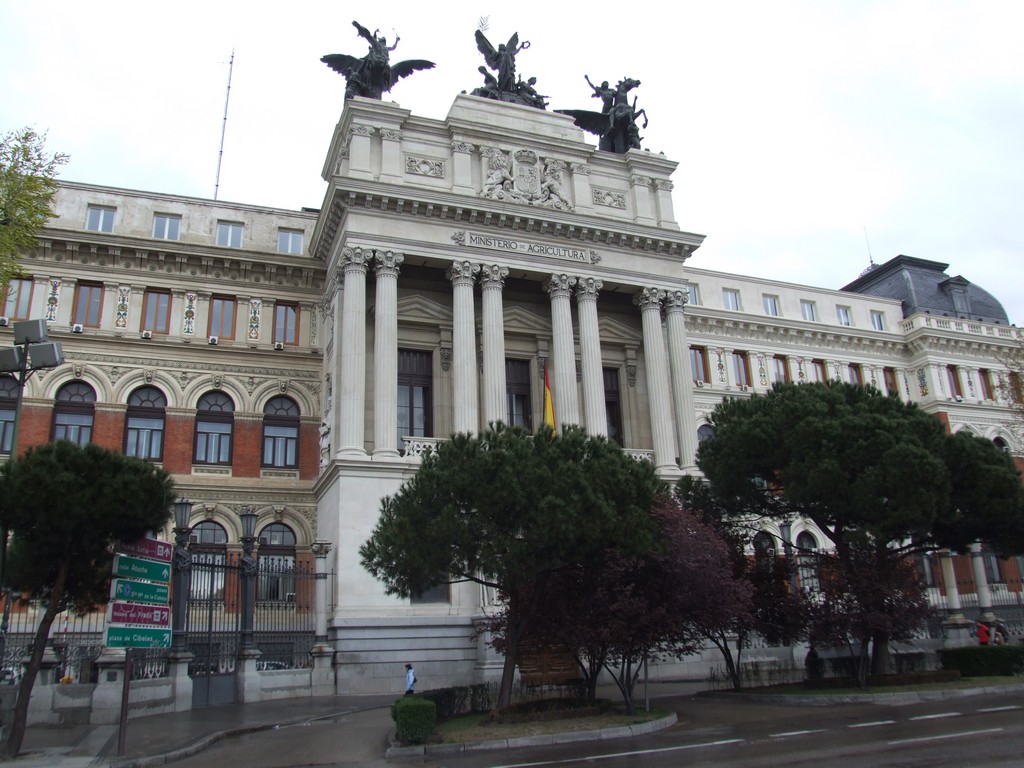
Ministry of Agriculture building.
“Welcome to the tropical island of Luton,” said the Easyjet pilot as we approached our landing. “It is a very pleasant 20 degrees Celsius outside and as you can see, quite sunny. It has been, all week.”
